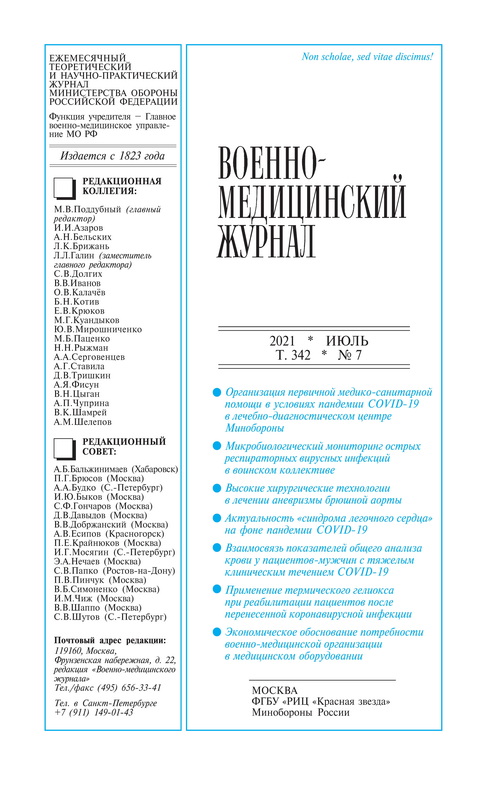Experience in the therapeutic use of an infrared laser in the complex treatment of metabolic eye disorders
- 作者: Orlovskaya L.E1, Borodin S.V1, Nefedov N.A1, Tarasenkov V.N1
-
隶属关系:
- Consultative and Diagnostic Polyclinic of the P.V.Mandryka Central Military Clinical Hospital of the Ministry of Defense of the Russian Federation
- 期: 卷 342, 编号 7 (2021)
- 页面: 52-58
- 栏目: Articles
- URL: https://journals.eco-vector.com/0026-9050/article/view/82630
- DOI: https://doi.org/10.52424/00269050_2021_342_7_52
- ID: 82630
如何引用文章
详细
The study aimed to evaluate the clinical effectiveness of laser puncture of biologically active points in the treatment of metabolic diseases of the eyes, methods of its application in the pathology of the anterior segment of the eye and the macular zone. Laser puncture of biologically active points has several advantages over acupuncture and their electrical stimulation: there is no need for acupuncture needles, which eliminates the pain factor during treatment, excludes the possibility of transmission of infection, wider indications for use. The procedure is safe and well - tolerated. The results were evaluated according to patient complaints, visual acuity, clinical picture, and the level of the critical flicker frequency of the light source. In most cases, an improvement or stabilization of the pathological process was noted.
全文:
作者简介
L. Orlovskaya
Consultative and Diagnostic Polyclinic of the P.V.Mandryka Central Military Clinical Hospital of the Ministry of Defense of the Russian FederationMoscow, Russia
S. Borodin
Consultative and Diagnostic Polyclinic of the P.V.Mandryka Central Military Clinical Hospital of the Ministry of Defense of the Russian FederationMoscow, Russia
N. Nefedov
Consultative and Diagnostic Polyclinic of the P.V.Mandryka Central Military Clinical Hospital of the Ministry of Defense of the Russian Federation
Email: nikolai210688@mail.ru
Moscow, Russia
V. Tarasenkov
Consultative and Diagnostic Polyclinic of the P.V.Mandryka Central Military Clinical Hospital of the Ministry of Defense of the Russian FederationMoscow, Russia
参考
- Абрамов М.В., Егоров Е.А. Зависимость эффективности низкоинтенсивной лазерной терапии инволюционной центральной хориоретинальной дистрофии от применяемой длины волны // Вестн. офтальмол. - 2004. - Т. 120, № 6. - С. 5-8.
- Буйлин В.А. Лазерная рефлексотерапия. - М.: Техника, 2002. - 34 с.
- Елисеенко В.И. Обоснование применения лазеров в клинической практике // В кн.: Клин. лазерология: Практ. рук-во / Под ред. А.Р.Евстигнеева, Л.П.Пешева. - Саранск; Калуга: РАО-Пресс, 2008. - С. 47-55.
- Кацнельсон Л.А., Аникина Е.Б., Захарова Г.Ю., Шапиро Е.Ш. Применение низкоэнергетического инфракрасного лазерного излучения для улучшения кровоснабжения и повышения функций зрения у больных с заболеваниями сетчатки: Метод. реком. / НИИ глазных болезней им. Гельмгольца. - М., 1996. - 7 с.
- Москвин С.В., Агасаров Л.Г. Лазерная акупунктура: основные принципы, методические подходы и параметры методик // Вестн. новых мед. технол. Электрон. изд-е. - 2019. - № 1. URL: https://cyberleninka.ru/article/n/lazernaya-akupunktura-osnovnye-printsipy-metodicheskie-podhody-i-parametry-metodik (дата обращения: 21.04.2021).
- Панков О.П. Экспериментальное обоснование и клиническое использование низкоинтенсивного лазерного излучения в офтальмологии // В кн.: Лазеры и аэроионы в биомедицине. - Калуга; Обнинск, 1997. - С. 126-136.
补充文件






